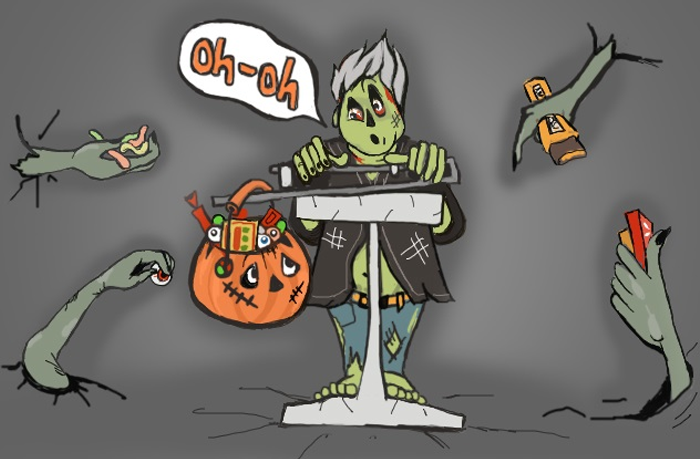
MoveMore Blog
The latest in workplace wellness

Zombie attack!: fighting Halloween weight gain horrors
You, a Halloween sugar zombie? Yes, you! The dead giveaway? Any time of day, at home or at work, your inner ghoul slips into attack mode, devouring every treat in sight.
It’s never easy to stay resolved to live and eat healthy, but Halloween is an especially scary holiday. And it’s the start of the holiday weight gain season that includes Thanksgiving feasts and concludes with New Year’s Eve revelry. (Then on January 1st the diet detox begins…)
So, how much candy craving temptation will you face this Halloween? Ergotron’s own Bob Hill crunches the numbers.
“I went to Cub Foods last night and got distracted by the approximate 40 feet of shelf space dedicated to Halloween candy. I like a Twix and Kit-Kat as much as the next guy, but …
Curious, I couldn’t resist doing some in-store math:
The average bag of pre-packaged Halloween candy has 15 servings per big bag x 125 calories per serving = 1,875 calories per big bag of Halloween candy, as a guesstimate.
Now, how many big bags of packaged trick-or-treat goodies were in this Halloween display? These are approximate numbers:
- 40 feet of shelf length x 7 shelves high
- 40 different “columns” of bagged candy stacked about 20 bags deep = 800 bags of candy per shelf
- 800 bags per shelf x 7 shelves = 5,600 bags total
- 5,600 big bags of individually wrapped Halloween candy x 1,875 calories per big bag = 10,500,000 calories of Halloween candy in that aisle.”
Good to know – big box stores hold enough Halloween candy to outlast the wildest cravings. But before you let your food monster feast on all that candy, check out this chart showing how to work off the calories in those bite-size indulgences:
Charleston Chew bar (10 minutes of trick-or-treating)
Hershey’s bar (15 minutes of dancing the Monster Mash)
100 Grand bar (5 minutes of running from villagers with pitchforks)
Reese’s Peanut Butter Cup (3 hours of standing versus sitting)
Our Calorie-Burn Calculator shows how adding more standing to your day can help you come back to the living after a feeding frenzy.
Beyond calories, health-conscious parents with trick-or-treating little goblins dread the sugar shock. One pillowcase can hold many pounds of loot and grams of sugar. The American Heart Association recommends that children consume less than 25 grams of added sugar daily. Those fun-size candies add up quickly! An Almond Joy clocks in at 8 grams, Baby Ruth at 10 grams, Dots at 11 grams, Jelly Belly Jelly Beans at 7 grams, Milk Duds at 6.3 grams, SweeTarts (are a bargain) at 2.4 grams, Skittles at 14.5, and Whoppers at 13 grams.
But even endocrinologists specializing in diabetes and child obesity experts warn parents against demonizing sugar. That just makes it more irresistible. You can set limits, though, to keep Halloween candy consumption from getting out of control. For instance, nix the trick-or-treat pillowcase in favor of a small plastic pumpkin. Or ration the candy: give out one piece for every year of age on the holiday, and then one piece each day after.
For a look at how the inner candyfreak comes unleashed on Halloween, watch this hilarious prank video from the Jimmy Kimmel show. For five years, they have asked parents to pretend they annihilated their children’s candy stash. Some kids are surprisingly forgiving, while others throw monstrous fits. And who can really blame them?
Relevant Posts
Stay in the know
Sign up and get the latest and greatest content from JustStand's MoveMore blog.